There are 249 bird families containing over 11,000 species, totaling over 50 billion birds that inhabit our earth! Some of the most abundant species include land fowl like domestic chickens and turkeys, or perching birds, such as crows and doves. But there are numerous categories of birds, including waterfowl, shorebirds, raptors, flightless birds, and those in their own classification. Discover some of the most common types of birds in the world and find out where they live and what they eat.
Passerines
Passerines are known as “perching birds,” and they include more than half of all bird species. Here are a few examples of passerines.
Blue Jay

Blue jays live near human habitations like cities and towns.
©iStock.com/BrianEKushner
Habitat: They are abundant across North America, where they inhabit many different kinds of forests. But you can also find them in gardens, groves, and towns.
Appearance: Blue jays are relatively large birds with crests and long, rounded tails. Their plumage is various shades of blue, white, and black.
Diet: Acorns, seeds, berries, grains, fruits, insects, spiders, small rodents, baby birds, and carrion
Vocalizations: Harsh cries and soft, liquid notes
Fun Fact: They belong to the corvid family, meaning they are related to crows.
House Sparrow
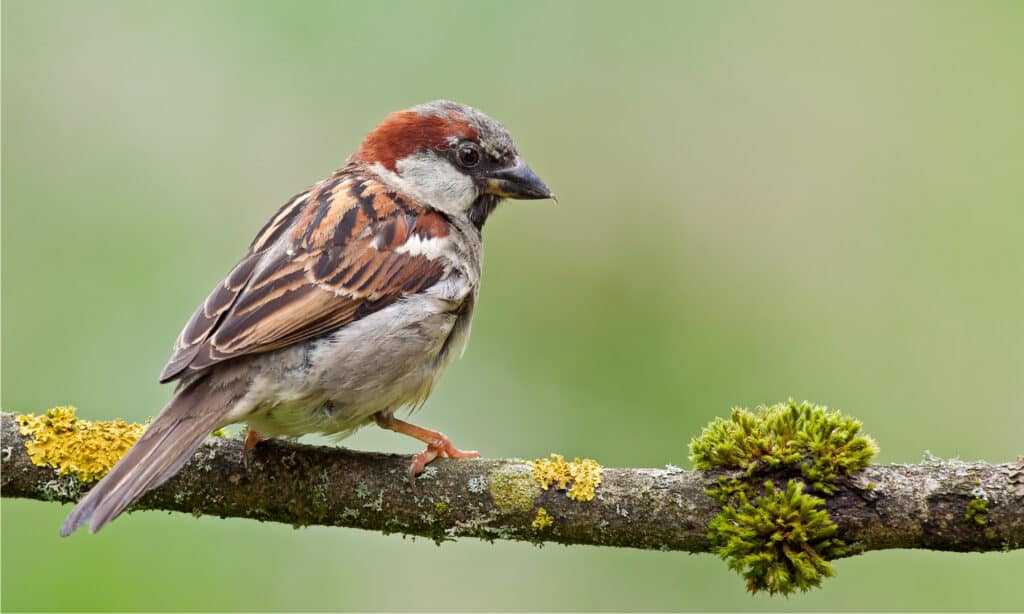
House sparrows eat insects and seeds.
©Rob Christiaans/Shutterstock.com
Habitat: House sparrows have a global distribution and are notorious for living near human habitations. Look for them in cities, towns, and farms.
Appearance: These stout birds have full chests, rounded heads, and relatively short tails. These sparrows are light gray with reddish-brown necks and wings. They also have patches of white and black on their faces.
Diet: Insects and weed and grass seeds
Vocalizations: shrill chirping and single “cheeps”
Fun Fact: House sparrows will swim underwater to escape predators.
European Starling
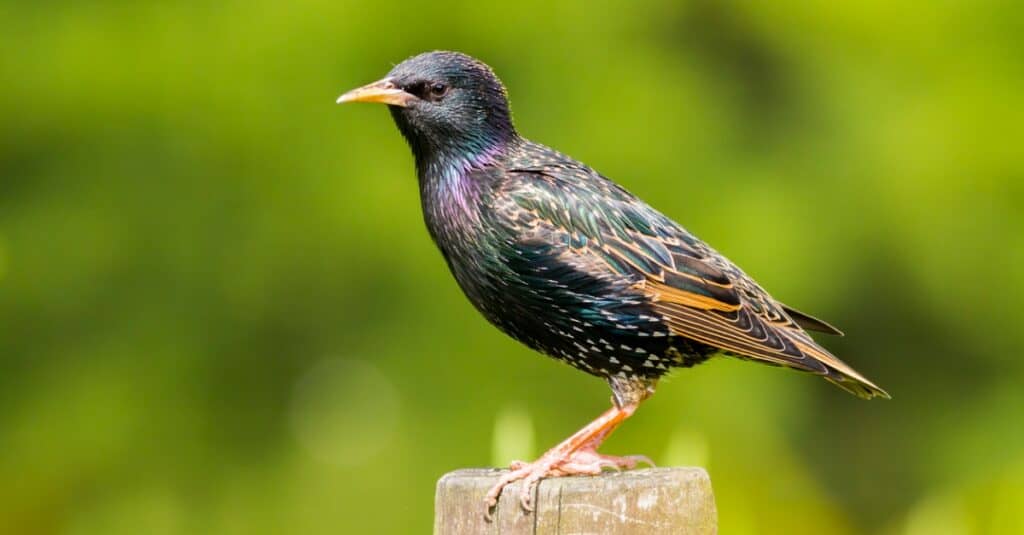
European starlings have glossy, iridescent feathers.
©iStock.com/chris2766
Habitat: The European starling is native to Eurasia but was introduced to Australia, Africa, and North America. They are very common around humans, inhabiting cities, parks, farms, and fields.
Appearance: These chunky birds have short tails, long beaks, and pointed wings. And their plumage is all-black with purple and green iridescence and yellow bills.
Diet: Insects, berries, and seeds
Vocalizations: Musical rasping notes and purr-like calls
Fun Fact: They are one of the most abundant birds in the United States, despite being an introduced species.
Raptors
Raptors, also known as birds of prey, are carnivores with excellent hunting skills. This category encompasses many birds, like hawks, eagles, ospreys, owls, vultures, and more.
Red-tailed Hawk
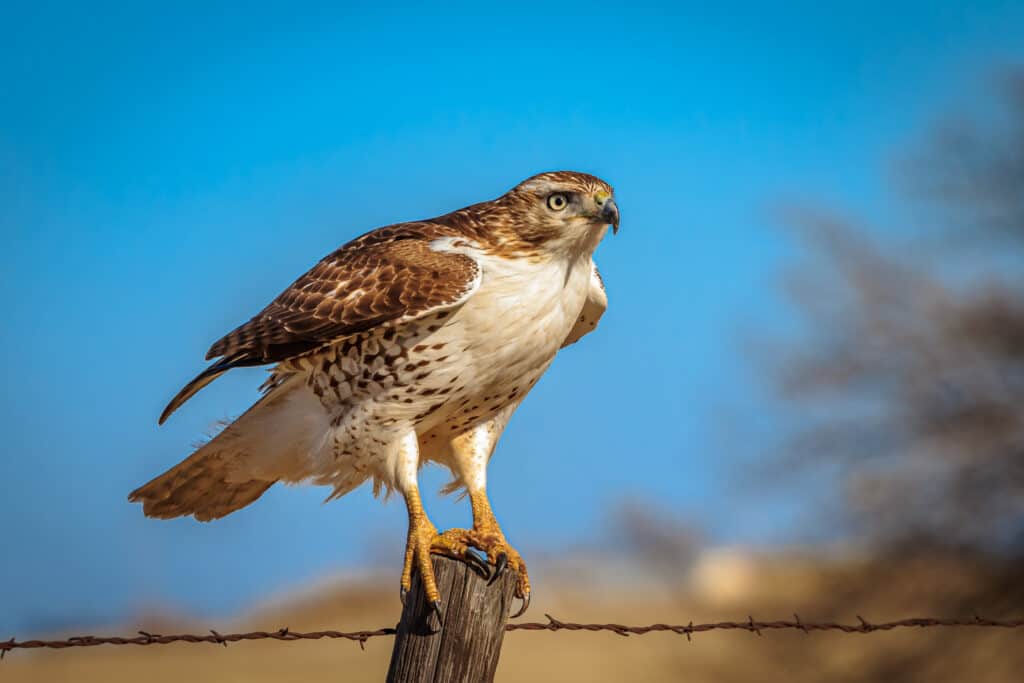
Red-tailed hawks mostly prey on live animals such as rodents and other small mammals.
©Richard G Smith/Shutterstock.com
Habitat: The red-tailed hawk lives across most of North America and is one of the continent’s most abundant hawk species. They live in open country, woodlands, prairies, mountains, and plains.
Appearance: These large hawks have broad, rounded wings and short, wide tails. They are rich medium-brown above and white below with a reddish-brown tail.
Diet: Small mammals, birds, reptiles, amphibians, and occasionally carrion
Vocalizations: Hoarse, high-pitched screams
Fun Fact: Their eyesight is eight times better than a human’s.
American Kestrel
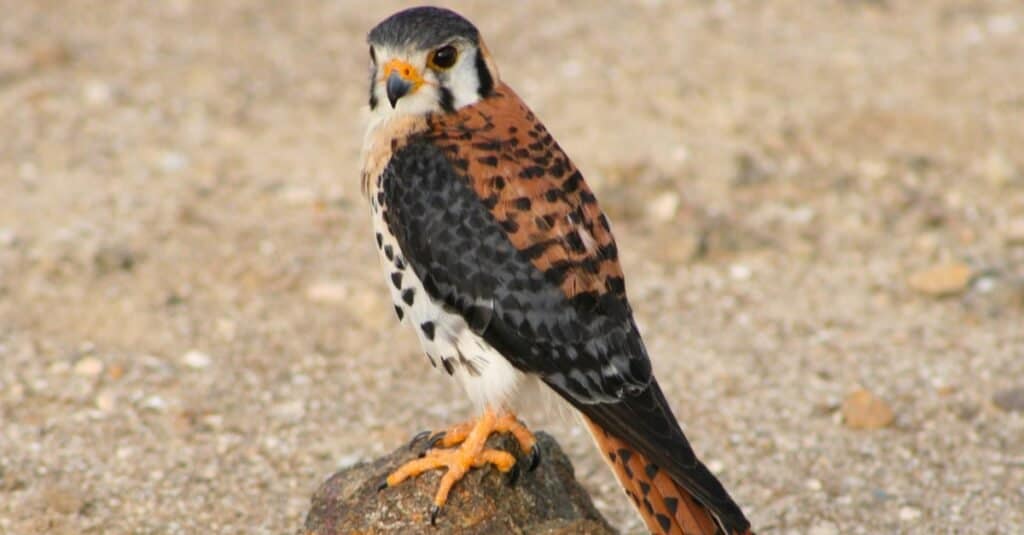
The American kestrel is the smallest falcon in North America.
©Megan M. Weber/Shutterstock.com
Habitat: American kestrels have a significant range across North and South America. They are birds of open country, but you can also find them near farms, cities, and forest edges.
Appearance: Their bodies are slender, and they feature narrow wings and long tails. Their plumage is a mixture of gray, rusty brown, and buff with black spots.
Diet: Large insects, small mammals, birds, and reptiles
Vocalizations: Shrill “killy” notes
Fun Fact: They are the smallest falcon in North America.
Bald Eagle

Bald Eagles are one of the largest birds in North America.
©Jack Molan/Shutterstock.com
Habitat: Bald eagles are native to North America, where they inhabit most of the continent. You can find them along coasts, rivers, lakes, open country, and mountains.
Appearance: These eagles are enormous birds with broad wings and long, hooked bills. They feature dark brown bodies, snow-white heads, and yellow beaks.
Diet: Fish, birds, mammals, and carrion
Vocalizations: High-pitched whistling and squeaky cackling
Fun Fact: They can fly 100 mph!
Waterfowl
The waterfowl order encompasses species highly adapted to an aquatic lifestyle. Most of the 180 species that make up this group are ducks, geese, and swans.
Mallard
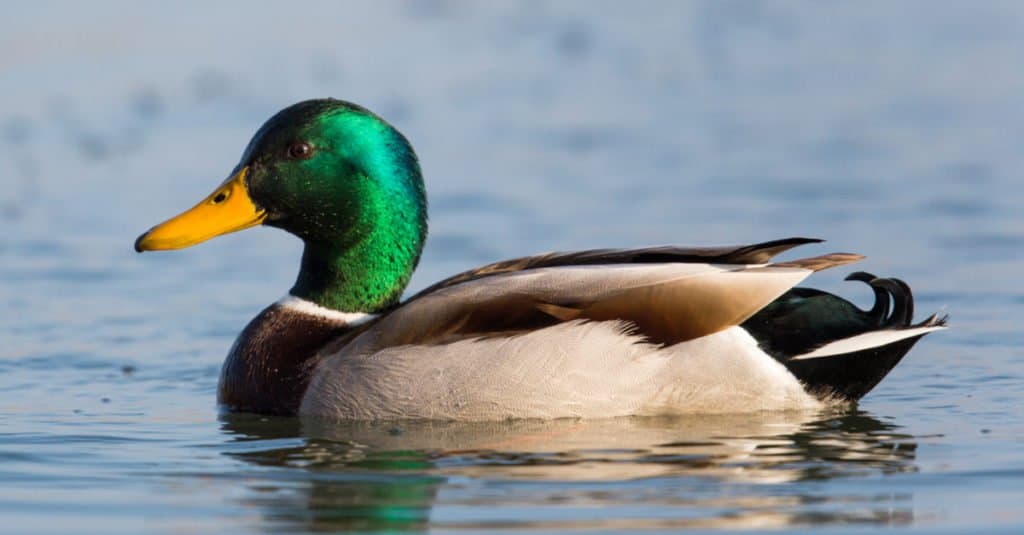
The mallard duck lives on lakes and ponds.
©Pascal Halder/Shutterstock.com
Habitat: The mallard has an extensive range across North America, Europe, and Asia. They live in marshes, wooded swamps, fields, ponds, lakes, and city parks.
Appearance: They are large ducks with round heads and flat bills. Adult males have brown bodies, iridescent green heads, yellow bills, and blue wing feathers.
Diet: Seeds, stems, roots, insects, crustaceans, and small fish
Vocalizations: Loud quacks and quiet rasping
Fun Fact: There are over 10 million mallards in North America.
Wood Duck
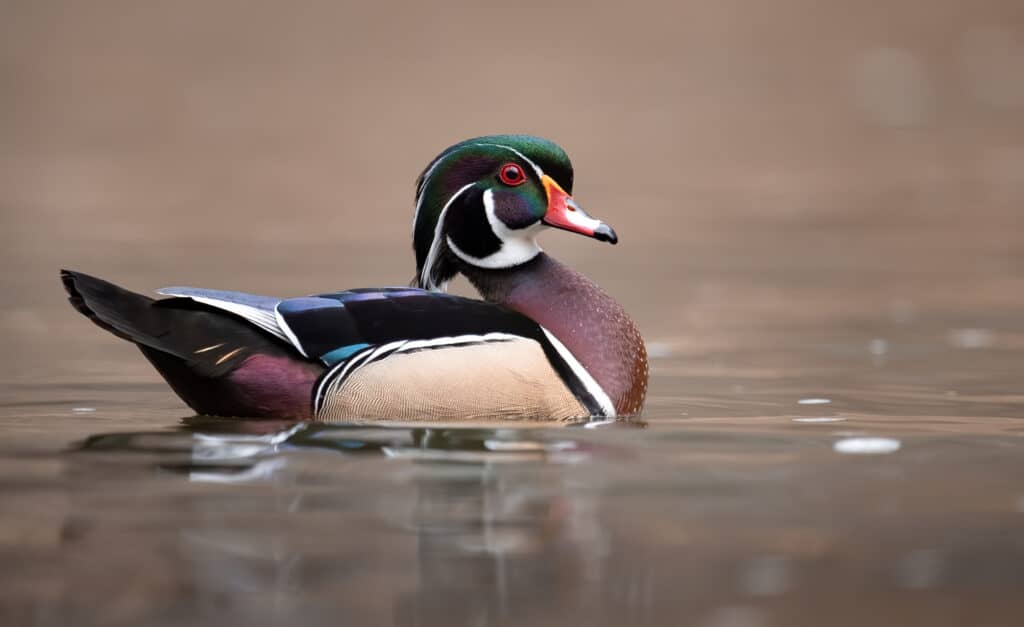
The wood duck has elaborate and colorful plumage.
©Harry Collins Photography/Shutterstock.com
Habitat: The wood duck is native to North America and most abundant in the eastern United States. Look for them in wooded swamps, rivers, and ponds.
Appearance: These unusual-looking ducks feature boxy, crested heads, slender necks, and long tails. Their plumage has many different colors, including reddish-brown, tan, black, white, blue, green, red, and yellow.
Diet: Seeds, aquatic plants, insects, and crustaceans
Vocalizations: Thin whistles and loud “woo-eek” calls
Fun Fact: They produce two broods in one year.
Canada Goose
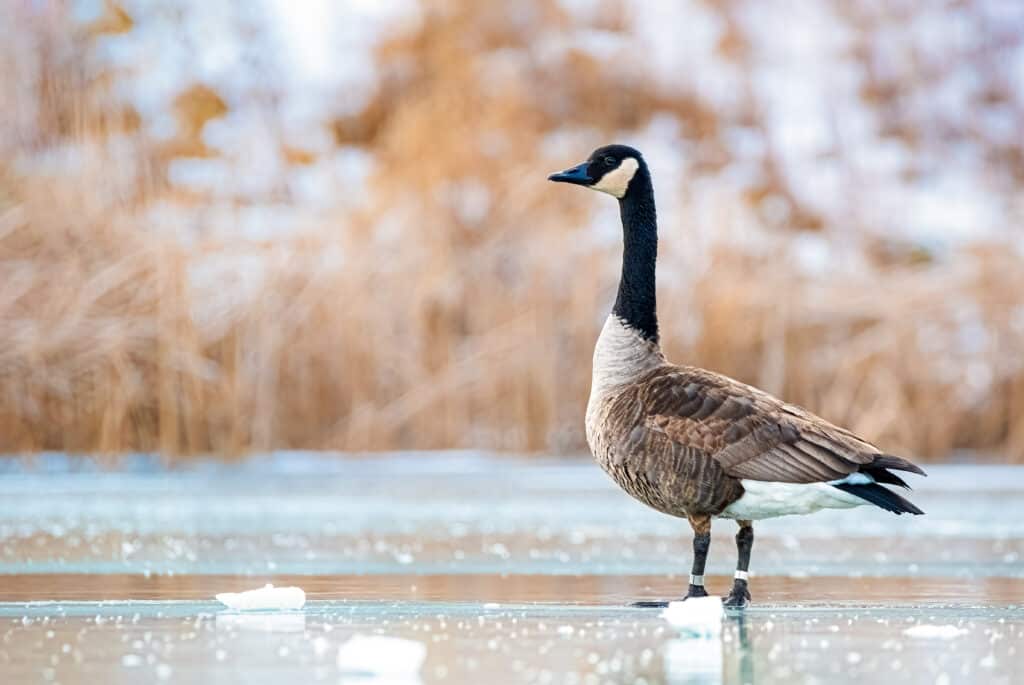
Canada geese produce musical honking sounds.
©Rogney Piedra Arencibia/Shutterstock.com
Habitat: Canada geese have an extensive range across Canada and the United States, with some populations in Europe. They inhabit lakes, ponds, bays, marshes, and fields.
Appearance: This large waterbird has a long neck, flat bill, and webbed feet. Their bodies are brown, and their heads and necks are black and white.
Diet: Stems, grass shoots, aquatic plants, insects, mollusks, and crustaceans
Vocalizations: Musical honking
Fun Fact: They can travel up to 1,500 miles in one day.
Flightless Birds
Through the process of evolution, some birds lost their ability to fly. There are over 60 living birds in this category, which include emus, rheas, penguins, ostriches, and several more.
Emu

Emus can travel great distances, and when necessary can sprint at 50 km/h (31 mph); they forage for a variety of plants and insects, but have been known to go for weeks without eating.
©iStock.com/Gilnature
Habitat: Emus are endemic to Australia, and their range covers the entire mainland. They live inland and near the coast but most commonly inhabit savanna woodlands and dry forests.
Appearance: They are the second tallest bird in the world, reaching up to six feet high. They have heavy bodies, long legs, and long necks. And their plumage is medium-brown all-over, with dark areas near the tail and lighter patches near the head and neck.
Diet: Seeds, fruits, flowers, insects, and small vertebrates
Vocalizations: Pig-like grunts and booming notes
Fun Fact: They have two sets of eyelids. The second set is dedicated to keeping dust out.
Emperor Penguin

Emperor penguins live near ice bergs and ice cliffs.
©Joey_Danuphol/Shutterstock.com
Habitat: The emperor penguin is endemic to Antarctica, where they trek across and breed on the ice. You will typically find them near ice cliffs and icebergs.
Appearance: They are the tallest and heaviest penguins on earth, weighing up to 100 pounds. These birds are white and pale yellow below and black above, with black heads and yellow necks.
Diet: Antarctic silverfish, krill, squid, and other fish
Vocalizations: Long, unique songs
Fun Fact: Some colonies are so huge they can be seen from space.
Ostrich
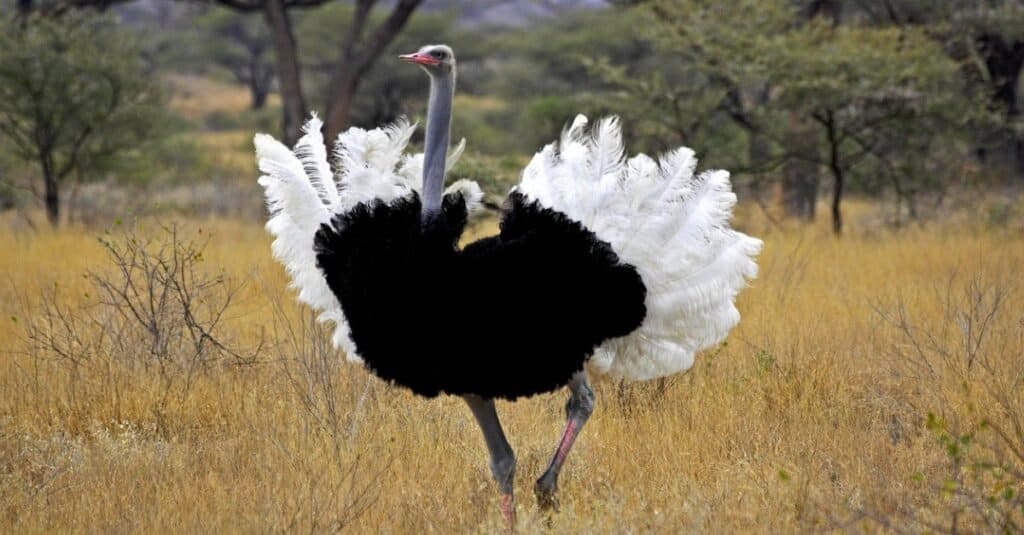
The male ostrich is black and white, and females are grayish-brown.
©iStock.com/slowmotiongli
Habitat: The common ostrich is native to Africa, where they live north and south of the equatorial forest zone. These huge flightless birds prefer to inhabit open lands, like semi-deserts and savannas.
Appearance: The ostrich has a heavy, oblong-shaped body with long, slender legs and long necks. They are the largest living bird species, weighing up to 320 pounds and reaching over six feet tall. Adult males are black and white, and females are grayish-brown and white. Their heads and necks have a thin layer of down, and their legs are unfeathered.
Diet: Roots, flowers, grasses, grains, fruits, insects, and small reptiles
Vocalizations: Trilling, honking, hissing, and whistling
Fun Fact: Ostriches can sprunt up to 43 mph. They are the fastest-running birds!
Up Next:
- 10 Incredible Bird Facts
- Birds: Different Types, Definition, Photos, and More
- Different Types of Pet Talking Birds
The photo featured at the top of this post is © PatP66/Shutterstock.com
Sources
- The Cornell Lab of Ornithology, Available here: https://birdsoftheworld.org/bow/news/new-feature-bird-family-overviews
- The Smithsonian Magazine, Available here: https://www.smithsonianmag.com/smart-news/50-billion-total-wild-birds-inhabit-planet-study-estimates-180977753/
Thank you for reading! Have some feedback for us? Contact the AZ Animals editorial team.






